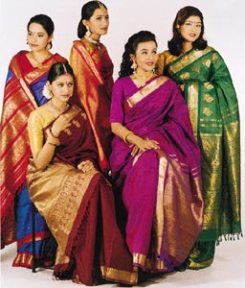By Valli Suluxana, VOICE Program Manager
I know what you are thinking. As soon as you read the word “dressing” in the title, your mind instinctively went to fashion magazines and fashion editorials, and thought that this would be an article showcasing the fashion in India. But, it is not. This is a blog entry about fashion as an expression of individuality, or in the case of India, the lack of fashion as a lack of personal expression. This is true throughout India, especially in Andhra Pradesh.
Fashion in the western world is constantly changing. Women wear pants, dresses, skirts, sportswear, etc. The same is true in India, to a degree. We have different types of outfits for different occasions in India as well. We have sarees, salwar kamiz, half saree, etc. However, the conventions of what to where during each occasion are a lot stricter in India. Dressing in India is not simply a means of expression or art; it is a means of complying with the societal rules and norms.
In Andhra Pradesh, girls under the age of 12 are allowed to wear frocks and skirts. However, once they hit puberty, they are not allowed to anything that would not cover the knees. Dressing of course varies from family to family. If one’s family is super conservative and strict, then one may have to wear a lot more layers and cover up. When I was a child, I was allowed to wear frocks and skirts that hung below my knees but showed my legs. However, once I was about 13 or so, my parents forbade me from wearing any frocks, skirts, or jeans. For them, these modern dresses and western clothing could potentially put me at risk for harassment. Not to mention, wearing such modern clothes simply is not part of our culture.
You can see in Andhra Pradesh that girls only wear kurtha pizamas or half sarees. In the case of a conservative family, the daughters and daughters-in-law are not even allowed to wear the kurthas because of how western they seem. In some communities, married women are only allowed to wear sarees. They cannot even change into a night suits for bed. There is also a preference of girls wearing half sarees before marriage and sarees after. A girl or woman who does not comply by these rules will get severely scolded and reprimanded for not understanding the local culture.
It is true that nowadays, people and cultures are becoming more progressive. Cities across India, such as Hyderababd, Vizad, and Guntur, are changing up their ways of dressing, becoming more lenient with what women wear. But, this change has not taken place in the villages. In villages, culture still dominates the way people dress.
As a workingwoman, I am allowed to wear suits only during work hours, after which I will go home and change into a saree. Personally, I don’t find this particularly restricting because it is the culture I have grown up with. I do believe that girls should have the right to wear what ever they feel the most comfortable in. But, if wearing a saree as opposed to a half saree will keep a girl safe, then why not? I know that girls are not to blame for the harassment and sexual assault that happen to them no matter what they wear. But, looking at fashion as a means of expression, we need to consider that some girls like veiling or covering up to convey their purity and their respect for their culture. Western culture’s way of dressing may be more progressive and lenient, but western culture also dictates what people wear. If we look at Indian women’s way of dressing as an embodiment of culture rather than as forms of restriction and oppression, then we can truly understand what a woman in a saree feels.

gr8 🙂
Hi webmaster do you need unlimited articles for your page ?
What if you could copy article from other sources, make it unique and
publish on your site – i know the right tool for you, just type
in google:
luiqight’s article tool